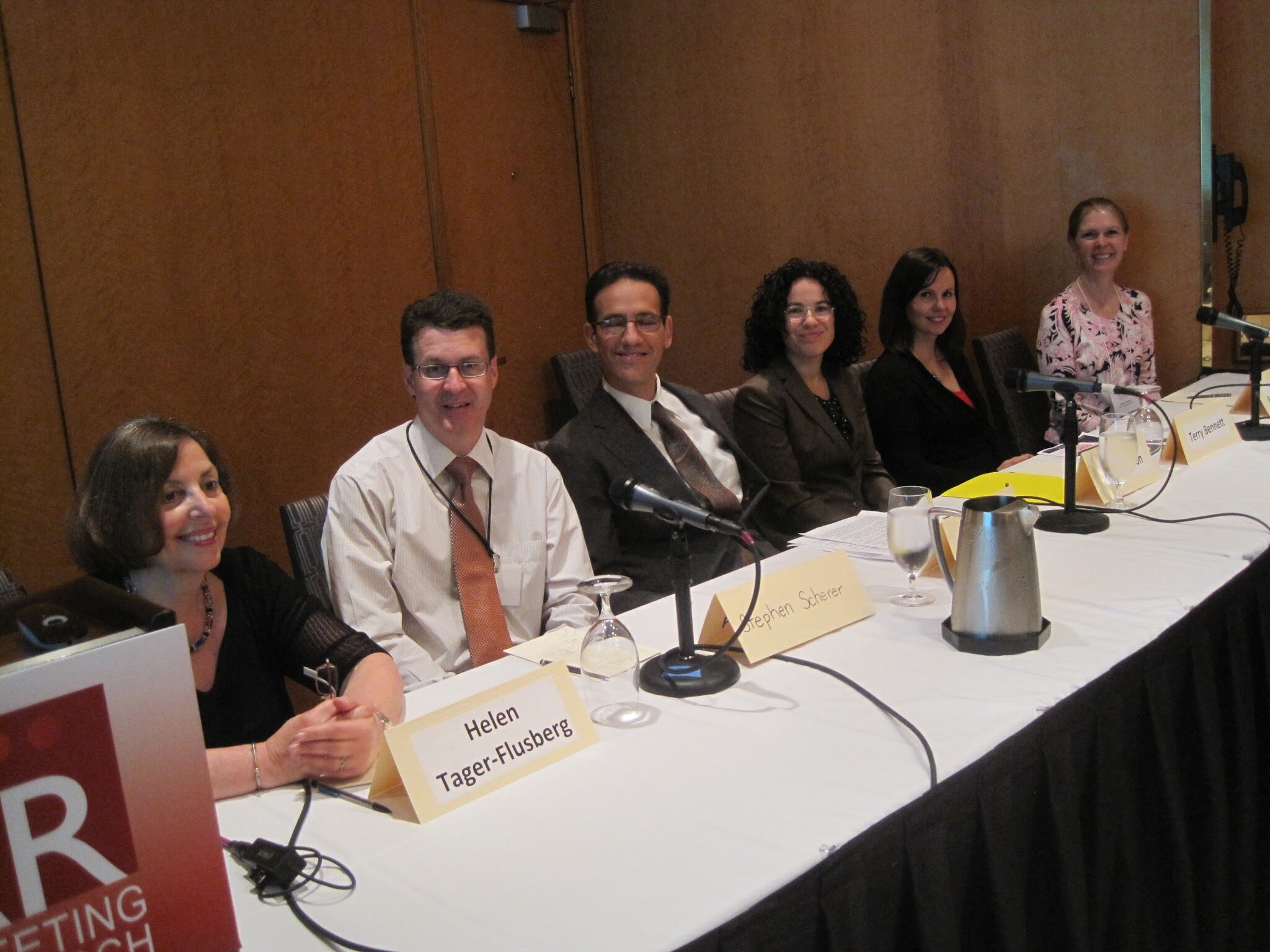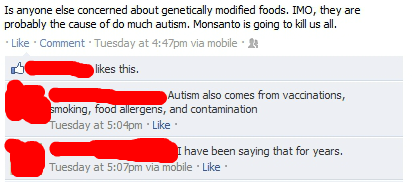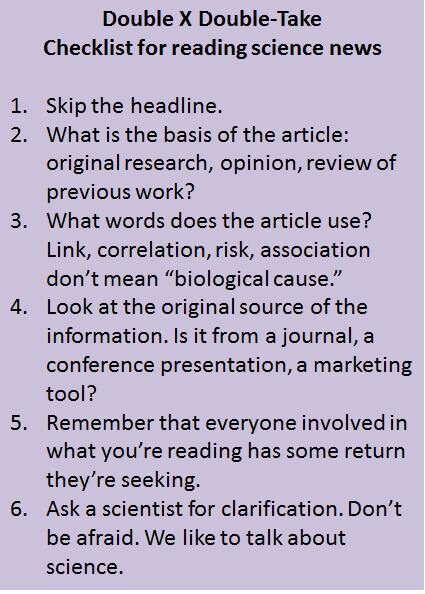Beautiful Toronto is a lovely setting for the explosion of information at IMFAR 2012. One way we are trying to bring the conference to those of you who could not attend is by using Twitter to “live tweet” sessions and events. Later, using Storify, we can piece back together those 140-character bites of information. The following is the Tweet story of an oral presentation entitled Friendship in ASD through the Life Span: Nature, Trajectories, Importance and Treatment. Any errors (including hastily-typed misspellings!) or omissions are mine. Please follow @thinkingautism, @jennyalice, @shannonrosa, @ejwillingham, and @aspieadvocate for more IMFAR 2012 conversation.The conference is using #IMFAR2012 to make finding and sharing information easier.-JBM
Month: May 2012
Alison Singer of the Autism Science Foundation introduced the speakers in her role as co-chair of IMFAR public relations committee. She noted that INSAR has encouraged autistic people and other community stakeholders to participate at IMFAR, as volunteers, etc. TPGA coverage of IMFAR will start in the morning! Don’t forget to follow us on @thinkingautism, and check back here for updates. —- The first speaker was the president of INSAR, Helen Tager-Flusberg: This conference’s goal is focusing on the very best science, and the immediate dissemination of it. INSAR, the International Society of Autism Research, is moving into second decade. The first conference had approximately 200 attendees, and was tagged onto neuroscience conference in Orlando, Florida. This year’s conference will be the largest ever, with well over 1800 people in main the main conference. (There is also a pre-conference on disseminating IMFAR 2012 work to parents, clinicians, and other stakeholders…
Can’t make IMFAR? Don’t worry, four of our TPGA editors are covering the International Meeting for Autism Research in Toronto, Canada, from Wednesday May 16 through Saturday May 19. Reporting starts with today ‘s 11 AM ET press conference (assuming Shannon & Jen make their flight, which has been delayed, eep — stand by). Panel & presentation coverage will be posted here www.thinkingautismguide.com, via Twitter, and of course on the TPGA Facebook page. Follow us on Twitter at @thinkingautism, @jennyalice, @aspieadvocate, @ejwillingham and @shannonrosa. And if you’re at IMFAR, you can also buy our books at the Autism Science Foundation table — 100% of sales benefit the ASF. If you see one of us, say hi! Science devotees out!
Jessica Severson theseversons.net Part one surveys the first part of the sequence of events by which research turns into pseudoscience, and “truth fades away in favor of headlines and pageviews and gossip.” Onward. Part Five: News Articles This is a process. First research, then op-ed, then press release and finally news articles. So what’s the headline of our news article? Top 10 Chemicals Most Likely to Cause Autism and Learning Disabilities. Guilty of serious fear mongering, no? A more accurate title may be: Researchers propose list of chemicals potentially tied to neurological development for further study. But I doubt anyone’s going to write that. The article itself, to be fair, is full of caveats. The reasons for the increase in autism are “controversial.” There is a “gap in the science.” But then you get a sentence like this: But clearly, there is more to the story than simply genetics, as…
Jessica Severson theseversons.net I am putting my foot down. As the parent of an autistic child I hear a lot about vaccines and about half a million other things that people think cause autism. I’m hyperaware of the attention autism gets in the media. So I know about the CDC’s new stats on autism rates. I know about the debate on whether the increase in autism is due to more awareness and diagnosis or more actual occurrences. (Personally, I find the former to be a serious factor, though who’s to say how much.) And I see all the articles that come out week after week about the millions of things that are linked to autism. There’s a recurring problem here. Valuable research is done. Research is disseminated. Information is reported. Articles are read. Findings are spread. And what starts in a lab ends up in a Facebook status. What starts…
Emily Willingham doublexscience.blogspot.com Natural News recently resurrected an OLD study about “monkeys with autism” that, when it came out two years ago (for the second time), was so egregious that many autism/science bloggers tore it to pieces. That hasn’t stopped Natural News from presenting it as “new.” So, we are running science editor Emily Willingham’s original reaction to the study, below. We also encourage you to read editor Liz Ditz’s overview of the entire history of this “study.” I was sitting across from a friend today at a picnic table when she received an email on her smart phone. A local parent who disseminates all manner of autism-related information and misinformation had circulated an email with a SafeMinds headline asserting that “scientific evidence” had emerged linking autism, vaccines, and mercury. Suppressing the impulse to hurl all over the beach towels at the prospect of yet another mole to whack (or,…
Shannon Des Roches Rosa www.squidalicious.com As many of us are planning summer excursions, here are the whys and hows of one autistic boy’s successful trip to Disneyland. Look, I grew up in Anaheim. Disneyland’s fireworks exploded over our house every summer night, and I played Dopey the Dwarf in the Main Street Electrical Parade. I couldn’t be more blasé about the house of Mouse, so if you told me that my former workplace would one day make me happy enough to cry, I’d have scoffed. But crying with happiness is exactly what happened during my autistic son Leo’s birthday trip to Disneyland — he had two full days of pure joy that melted my cold, hard, meh-filled heart. For my son, it really was a Magic Kingdom. Photo of Leo by his uncle Mike Des Roches Leo hadn’t been to Disneyland since 2004 because the interim years were challenging ones…
Diane Lightfoot www.unitedresponse.org.uk/what-we-do/how-we-work/supported-living United Response was set up in 1973 to provide a service based on supported living principles to a handful of adults with learning disabilities in a house in West Sussex. At the time, most such adults usually found themselves placed in institutions, isolated from the rest of society, with few rights and fewer opportunities to live a full and active life. Forty years after that first house was set up, United Response now supports over 2,000 individuals in almost 300 locations across [The United Kingdom], but supported living is still at the core of our work. The majority of our support is officially “supported living” where we support people living in their own homes, with their own rights as tenants or owners, but where we support people in homes that are registered as residential care, we run these along the same principles; enabling people to have control…
J. Lorraine Martin cheeselesspizza.blogspot.com The setting was surreal: a mountain range, cast in orange hues against a crisp blue sky; cactuses dotting the landscape and the occasional roadrunner darting across a street; row upon row of well-tended tennis courts and throngs of onlookers all dressed in their tennis best. It felt unimaginable that my daughter’s neighborhood tennis team had played a year of matches leading them all the way to a coveted spot at the National Championships in Tucson, Arizona. Amazingly, it came down to the final match with my daughter representing her team in singles. My heart was pounding, a whirlwind of joy and nervousness weaving through all the struggle and collective effort to reach such a thrilling moment in time. Years later, I found myself witnessing a moment involving my oldest son that carried the same beautiful thread of perseverance; however, before one can understand the depth and…
Emily Willingham doublexscience.blogspot.com www.ThinkingAutismGuide.com Handy short-form version. [image: Light purple vertical rectangle, with black text reading: Double X Double-Take Checklist for reading science news 1. Skip the headline. 2. What is the basis of the article: original research, opinion, review of previous work? 3. What words does the article use? Link, correlation, risk, association don’t mean “biological cause” 4. Look at the original source of the information. Is it from a journal, a conference presentation, a marketing tool? 5. Remember that everyone involved in what you’re reading has some return on what they’re seeking. 6. Ask a scientist for clarification. Don’t be afraid. We like to talk about science.] You’ve probably seen a lot of headlines lately about autism and various behaviors, ways of being, or “toxins” that, the headlines tell you, are “linked” to it. Maybe you’re considering having a child and are mentally tallying up the various risk factors…



